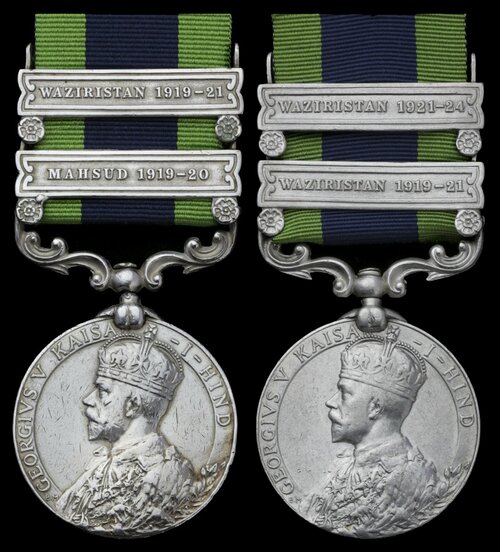
Auction: 22001 - Orders, Decorations and Medals
Lot: 101
India General Service 1908-35, 2 clasps (2), Mahsud 1919-20, Waziristan 1919-21 (5302 Rfmn. Pahal Chand, 2-9 Grks.); Waziristan 1919-21, Waziristan 1921-24 (5681 Rfmn. Mandhoj Gurung, 2-3 Grks.), nearly very fine (2)
The 2nd Battalion 9th Gurkha Rifles (2-9GR) served in the Kohat area during the Third Afghan War but did not take an active part in operations.
The Battalion had only returned to Dehra Dun in March 1919 after two and half years' service in Mesopotamia. On the outbreak of the Third Afghan War, 2-9GR was ordered to mobilise on 13th May and provide a draft of two hundred men to join 1-9GR on the Khyber front. The remainder of the Battalion moved to Kohat at the end of May and was encamped with 2-7GR near the railway station. Following a severe outbreak of cholera in the Kohat cantonment, from which the Battalion suffered several casualties, it moved to Hangu in mid-June, where it remained until July when it returned to Dehra Dun. While at Hangu, an attack by rebel tribesmen on a Battalion picquet was successfully repulsed at a cost of two Gurkhas wounded. In addition to the draft it provided to 1-9GR, the Battalion transferred two complete companies to 3-9 GR and 3-8GR respectively in June 1919; within three months of its return from Mesopotamia, nearly three quarters of the Battalion's strength had been sent to other units.
All three battalions of 9th Gurkha Rifles took part in the Third Afghan War and those eligible were awarded the Indian General Service Medal 1908 clasp AFGHANISTAN N.W.F. 1919. There is no record in the Regimental History of any casualties or honours and awards to the 2nd Battalion as a result of the Afghan War. The Regiment was also awarded the Battle Honour AFGHANISTAN 1919.
The 2nd Battalion deployed to Dardoni, to the west of Bannu and adjacent to Miranshah, in December 1920 where it served throughout 1921 . Here it joined the 7th Brigade and was employed in convoy protection and picquet duties.
In November 1921, the authorities had decided to arrange a settlement with tribes in the Upper Tochi and re-establish a militia post at Datta Khel . The 2nd Battalion formed part of the Datta Khel column, which moved out of Dardoni on 26th November and reached Datta Khel, via the Spinchilla Pass, on 30th November, having established a forward base at Mahomed Khel. A reserve of supplies was then laid in at Datta Khel and work commenced on the post to be held by the militia on the withdrawal of regular troops.
On 4th December, two companies of 2/3 GR were redeployed to garrison the forward base at Mahomed Khel.
On 11th December, an empty convoy of camels and mules left Datta Khel, escorted by 2-69th Punjabis. The foothills from the Spinchilla Pass to Mahomed Khel were picqueted by a company of 2/3 GR. On leaving the Spinchilla Pass, large numbers of tribesmen attacked the convoy and although it reached Mahomed Khel safely, the 2-69th Punjabis escort had to fight a severe rear guard action for the last 3 miles. During this withdrawal, the 2/3 GR company which provided the picquets became separated from the 2-69th Punjabis escort and, finding itself attacked on all sides by an enemy estimated at being 400 - 500 strong, abandoned its dead and wounded in order that it could reach the safety of Muhomed Khel. As a result of this action, 2/3 GR casualties were 23 killed (to include the company commander, Major Paget) and 19 wounded.
Garrison life at Dardoni and the action on 11th December is described in detail by John Morris, who was serving as a captain in 2/3 GR at the time, in his autobiography "Hired to Kill" . He relates that as the picquets of his company began to withdraw they became cut off from the main column and were attacked from all sides by enemy tribesmen. In desperation, his company, which was widely dispersed, fought its way back to the safety of Mahomed Khel, being forced to leave both its dead and wounded. Early the next morning, he describes how they went back to discover the dead lay scattered in small groups and that from their postures, except for the fortunate few who had been killed instantly, every man had been subjected to the most barbarous treatment while still alive by the enemy tribesmen. The bodies had been stripped and in every case the genitals had been roughly severed and stuffed into the victim's mouth.
Throughout the remainder of December 1921 and during January 1922, the Battalion was employed in helping to build the new fort for the militia at Datta Khel. It left Datta Khel for Dardoni in February 1922, where it was stationed for the rest of 1922.
Although the regimental history does not record any honours and awards to the Battalion as a result of operations in Waziristan for this period, Deeds of Valour Performed by Indian Officers & Soldiers during the Period 1860 - 1925 , records that 694 Rifleman Manbahadur Gurung, 2nd Battalion 3rd Queen Alexandra's Own Gurkha Rifles was awarded the Indian Order of Merit, 2nd class for conspicuous gallantry in action near Muhammad Khel, North West Frontier, on 11th December 1921. The Indian Distinguished Service Medal also lists awards of the IDSM.
Subject to 20% VAT on Buyer’s Premium. For more information please view Terms and Conditions for Buyers.
Sold for
£140
Starting price
£60




